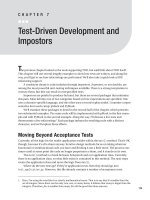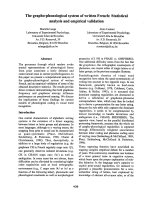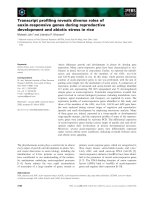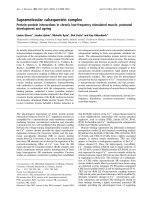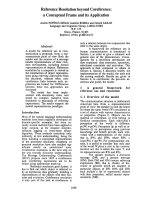dynamic time-based postponement- conceptual development and empirical test
Bạn đang xem bản rút gọn của tài liệu. Xem và tải ngay bản đầy đủ của tài liệu tại đây (35.35 MB, 267 trang )
“You don’t really understand something
until you can explain it to your grandmother.”
Albert Einstein
DYNAMIC TIME-BASED POSTPONEMENT:
CONCEPTUAL DEVELOPMENT AND EMPIRICAL TEST
DISSERTATION
Presented in Partial Fullfilment of the Requirements
for the Degree Doctor of Philosophy
in the Graduate School of The Ohio State Univeristy
By
Sebastián Javier García-Dastugue
*******
The Ohio State University
2003
Dissertation Committee:
Professor Douglas M. Lambert, Adviser
Professor Keely L. Croxton
Professor Thomas J. Goldsby
Approved by
__________________________________
Adviser
Business Administration
Copyright by
Sebastián Javier García-Dastugue
2003
ii
ABSTRACT
The purpose of this research was to present the conceptual development
of dynamic time-based postponement and empirically test the concept in the
context of the management of short-lived products in a supply chain formed by
independent firms. The conceptual development of dynamic time-based
postponement was based on a review of the literature. The empirical test was
performed with actual data from past limited-time offers in the quick-service
restaurant business.
Postponement, the deliberate delay of activities, is used to reduce the
acquisition, manufacturing and logistics costs while maintaining or increasing
customer service levels. Traditionally, postponement is implemented by changing
the sequence in which activities are performed. The sequence of activities is
changed by modifying the design of the product or the manufacturing processes,
or by reconfiguring the supply chain network structure. In this research,
postponement is implemented without changing the product, the manufacturing
processes or the network structure.
Dynamic time-based postponement is an extension of postponement to
situation where the extent to which postponement is used is adapted to the business
environment. Postponement as described here is time-based because only the
time when activities are performed is affected; that is, the sequence in which
activities are performed is not changed. Dynamic time-based postponement is
dynamic because it represents a method for capturing a number of managerial
objectives that change within a short time horizon. Early in the life cycle of the
iii
product, speculation is the strategy of choice for positioning inventories across the
supply chain. Speculation is used to minimize the risk associated with running out of
stock. It is generally more expensive to speculate than not to because inventory is
held at a higher cost and products are differentiated. Later in the life cycle,
uncertainty of demand is to a considerable extent dissipated and the focus is cost
minimization as for a standard product. Finally, close to the end of the life cycle,
obsolescence becomes a considerable cost driver, and shorter and more expensive
lead times are used in order to reduce inventory investment at risk of obsolescence.
The use of shorter lead times allows management to delay activities and to maintain
product in a non-committed status for longer. In this research setting, product is
maintained in a non-committed status by holding raw materials instead of finished
goods in stock and/or by delaying its geographic differentiation. The objective for
dynamic time-based postponement is to reduce safety stocks wherever it is possible
by determining the tactical locations of safety stocks across the supply chain which
might be different at different phases of the life-cycle of the product.
Data for the quantitative test were provided by four independent companies
in a supply chain operating in the restaurant industry. The four companies were
two manufacturers of ingredients, one distributor with nine distribution centers, and
quick-service restaurants owned by a franchisor. These four companies had supplier-
customer relationships, worked closely, but were independent from each other
and did not share ownership.
Collected data included manufacturing runs, interplant transportation,
shipments to next-tier customers, sales to end-customers, emergency transshipments,
and cost data. These data were integrated into a single database and used to
estimate the size of the business opportunity for the supply chain as a whole. They
were used also as input to an optimization model used to determine the tactical
locations and levels of safety stock across a supply chain. Conclusions were drawn
by comparing various scenarios produced with the optimization software.
iv
The major conclusions of this research were:
1. The main conclusion of this study was that adapting inventory policies across a
supply chain from speculation to postponement in short-time periods has
potential to produce cost savings to the supply chain. This allows managers to
integrate apparently conflicting objectives such as to guarantee product
availability even with uncertain demand, reduce costs as demand becomes
more predictable, and minimize obsolescence as the end of the life-cycle draws
near. Dynamic time-based postponement represents a method to focus on
each of these objectives at different phases of the product’s life-cycle.
2. The assessment of dynamic time-based postponement was presented here in
detail. This dissertation includes a detailed description of the data that were
collected, how these data from a number of sources were integrated to analyze
the supply chain as a whole, the issues that were encountered in this process,
and the quantitative analyses performed. This dissertation was meant to provide
managers willing to integrate activities beyond the single firm with a roadmap
for assessment of the business opportunity and for its implementation.
3. In this research setting, dynamic time-based postponement could produce a
cost saving of between $5.3 and $6.9 million annually while improving product
availability from approximately 92% to 99.5%.
4. Despite the closeness of the relationships among the members of the supply
chain, there was reluctancy to share data. Confidentiality concerns seemed
to be the single most critical factor to evaluate supply-chain-wide initiatives.
This was a problem even in this research setting, in which companies work as
extensions of each other at many organizational levels. There was considerable
openness to share transactional data; there was reluctancy to share cost data.
Suppliers felt they were at risk of giving away information that could be used to
negotiate better deals in the future.
v
5. Dynamic time-based postponement represents an approach to a true
implementation of collaborative replenishment. Traditionally, the channel
captain sets static inventory policies with which other supply chain members
have to comply. Dynamic time-based postponement requires that activities
are integrated across key supply chain members to reach its full potential and
make the supply chain as a whole more efficient.
There are three key differentiating aspects of this dissertation. First, this
dissertation is research in supply chain management; that is, research that views a
supply chain formed by several independent organizations holistically and that
extends beyond a dyad. The second aspect is that postponement is viewed as a
dynamic approach based on information sharing and the managers’ willingness
to coordinate activities beyond a single firm; and that it is implemented without
changing any aspect of the product, the manufacturing process or the supply
network structure. The third differentiating aspect is that, in this research, it is
recognized that postponement can be implemented by changing only the time
in which activities are performed, rather than by changing the sequence of
activities.
vi
Este trabajo está dedicado a mis padres, Inés y Juan Carlos, quienes
siempre se esforzaron por darme lo mejor de ellos (
a
).
A la memoria de mi padre, Juan Carlos,
a quién tendré presente por siempre (
b
).
a) Dedicated to my parents, who always have provided me with their best.
b) To my father who will be in my memory forever.
vii
ACKNOWLEDGMENTS
Several people interacted with me during the writing of this dissertation. To
all of them I am extremely thankful for their support and their help. A dissertation
grants a doctorate to a person, but there is at least a bit of this enterprise that
belongs to each of these individuals.
I would like to thank to the executives of the companies that participated in
this research, who dedicated their time. Without their help this research would not
have been possible. They not only provided the data, but explained (sometimes
several times) many aspects of their industry.
To the members of The Global Supply Chain Forum at the Fisher College of
Business, who listened to reports of my progress at several meetings. Their comments,
questions, general feedback, and reactions to those presentations certainly made
me be better prepared to continue making progress.
To Professor Douglas M. Lambert, Director of The Global Supply Chain Forum
and Chairman of my dissertation committee; who saw my potential early in the
doctoral program; who taught me endlessly; who helped me grow professionally
and personally by providing me with challenges in teaching, writing and presenting
my research interests; and who let me know when I could do better. There is not a
doubt in my mind that this journey would not have been as exiting and stimulating
if Professor Lambert had not given me his full support and dedicated time to my
education when I needed it.
To Professors Keely L. Croxton and Thomas J. Goldsby, who, together with
Professor Lambert, formed my dissertation committee. Their guidance through the
process of writing this dissertation was invaluable. Both played a central role in
viii
helping me ride the emotional roller coaster of writing a dissertation. Their openness
and accessibility made this process tolerable.
I also want to express my gratitude to Professor Sean Willems from Boston
University. Professor Willems not only let me use the software used for the quantitative
analysis for this research, but also dedicated his time to answering my questions
and guiding me in the use of the optimization software. I will never forget the time,
when even though he was working late at night, he spent more than an hour on
the phone with me working together to find a solution to a problem.
I also want to thank Professors Martha C. Cooper and Walter Zinn, from the
Marketing and Logistics Department at the Fisher College of Business. They with the
three members of my dissertation committee, provided the environment to learn
an enormous amount inside the classroom, doing research, or during informal
conversations on the corridors. I had the good fortune to interact with all of the
logistics faculty. Unquestionably, this interaction was the best feature of my doctoral
program.
To my fellow doctoral students who helped to make everyday a fun day
and with whom I shared both exiting and frustrating moments. To the staff of the
Department of Marketing and Logistics, at the Graduates Office at the Fisher
College of Business, and at the Office of International Education.
To Ignacio and Victor, who belived in me. Without their motivational sparks,
I never would have pursued my doctoral degree. This dissertation represents the
end of a wonderful journey and the beginning of another one. I decided to
accompany Ignacio in his endeavor to build a world class logistics program in
Argentina several years ago, because I believed that being with great people
makes great things happen. So far, this belief has been reinforced strongly.
To Stan, my past office-mate and my friend, who passionately helped me
improve my English, who patiently guided me through learning the academic
ix
environment of the United States, and from whose experiences, both good and
bad, I learned plenty.
To a friend, who was always there (and I am sure that he always will be) to
help, listen, or argue whatever was needed at the time. To this friend who taught
me both with his actions and his words; who demonstrated, countless times, how
to implement his first law of consulting: “help is defined by those who get it, not
those who give it”. To my dear friend Steve.
At last, but certainly not least, to Cecilia, who followed me to the other side
of the world leaving behind her family ties and putting on hold everything just to be
by my side. To the mother of Valentina, our first daughter who is growing up
beautifully thanks to Cecilia’s love. To my caring wife, I owe her the most because
at the end of the day for the past four years, she was always waiting for me at
home.
x
VITA
Education
1992 Bachelor of Arts, Management Information
Systems, Universidad C.A.E.C.E., Buenos Aires,
Argentina
1996 Master in Business Administration, Instituto de
Altos Estudios Empresariales (IAE), Universidad
Austral, Buenos Aires, Argentina
2002 Master of Arts, Business Administration, Logistics,
Fisher College of Business, The Ohio State
University
2000 - present Research Associate, The Global Supply Chain
Forum, The Fisher College of Business, The Ohio
State University
Professional Experience
1997-1999 Change Agent, Cementos Avellaneda,
Buenos Aires, Argentina
1997-1999 (part time) Consultant to ING Systems, Buenos Aires,
Argentina
1996-1999 (part time) Faculty, Instituto de Estudios para la Excelencia
Competitiva, Buenos Aires, Argentina
xi
1996-1997 Logistics Engineer, Ryder Argentina,
Buenos Aires, Argentina
1993-1996 Information Systems Engineer, Solutions
Informatiques Françaises, Buenos Aires,
Argentina
1992-1993 Information Systems Technical Support, Sud
Amércia Seguros, Buenos Aires, Argentina
PUBLICATIONS
1. Croxton, Keely L., Sebastián J. García-Dastugue, Douglas M. Lambert and Dale
S. Rogers, “Supply Chain Management Processes,” The International Journal of
Logistics Management, Vol. 11, No. 2 (2001), pp. 13-36.
2. Dale S. Rogers, Douglas M. Lambert, Croxton, Keely L., and Sebastián J. García-
Dastugue, “Supply Chain Management Processes,” The International Journal
of Logistics Management, Vol. 13, No. 2 (2002), pp. 1-18.
3. Croxton, Keely L., Douglas M. Lambert Sebastián J. García-Dastugue, and Dale
S. Rogers, “Demand Management,” The International Journal of Logistics
Management, Vol. 13, No. 2 (2002), pp. 51-66.
4. García-Dastugue, Sebastián J. and Douglas M. Lambert, “Internet-enabled
Coordination in the Supply Chain,” Industrial Marketing Management, Vol. 32,
No. 3, 2003, pp. 251-263.
FIELDS OF STUDY
Major Field: Business Administration
Areas of Specialization: Logistics and Management Information Systems
xii
TABLE OF CONTENTS
Abstract ii
Dedication vi
Acknowledgements vii
Vita x
List of Tables xvi
List of Figures xviii
Chapters:
1. Introduction 1
Background 3
The Business Problem 4
The Business Opportunity 5
The Research Purpose 9
Research Objectives 11
Research Questions 11
The Scope of the Research 12
Limitations 12
Potential Contributions 13
Organization 14
References 15
2. Conceptual Foundations: a Review of the Literature 16
Management of Limited-Time Offers 17
Uses of Limited-Time Offers 19
The Challenge of Managing LTOs 22
Management Throughout the Life Cycle of a LTO 23
xiii
Forecasting and Initial Ordering 23
Markdowns During a LTO 25
Replenishment Throughout a LTO 25
Summary of Management of LTOs 30
Supply Chain Management 31
Supply Chain Management Frameworks 33
Supply Chain Management and the Management of LTOs 37
Modeling Inventory Management in the Supply Chain 40
Postponement 45
Evolution of the Concept of Postponement 49
Two Views of Postponement 53
To Postpone or Not to Postpone?:
That Is
Not the Question 63
Number of Decoupling Points in the Supply Chain 66
Postponement: Half a Concept 67
How is Postponement Measured? 69
Summary of the Review of the Literature in Postponement 70
Postponement and the Management of Limited-Time Offers 71
Supply Chain Management Opportunities in Postponement 72
Dynamic Time-based Postponement: Conceptual Development . 75
Summary of Literature Review 82
References 84
3. Research Design 95
Research Setting 95
Description of the Supply Chain Used for this Research 98
Data Collection 105
Description of the Analysis 108
The Optimization-based Support System 111
Brief Description of the Optimization Algorithm 114
Stationary Single-Stage Inventory Model 114
Mechanics of the Optimization Algorithm 116
Summary 120
References 120
4. Data Analysis and Findings 121
Data Collection 121
Creating a Single Database for the Supply Chain 126
Importing Files and Structuring Data 126
Standardizing Data Formats 131
Building in Traceability of Transactions 131
Normalizing the Database 132
Detecting Errors and Improving Data Quality 132
xiv
Documenting the Database 133
Communication with Data Owners 133
Description of the Data Collected 134
Forecast 134
Actual Transactions Form Information Systems 138
Scaling Data of the Supply Chain 139
Initial Diagnostics of the Supply Chain Dynamics 144
Inventory Is Built Early in the Life-Cycle of the LTO 144
Order Placement 149
Planning 149
Obsolescence 152
Assessing the Cost of a LTO to the Supply Chain 153
Inventory Holding Costs 154
Obsolescence of Product Left Over 154
Transshipments 155
Determining the Size of the Visible Business Opportunity 157
Modeling Dynamic Time-based Postponement 161
Limits to the Use of Postponement 161
Degree of Predictability of Demand 163
Total Logistics Cost Trade-Offs 165
Dynamic Time-based Postponement in this Setting 168
Developing the Optimization-based Model 171
Modeling the Business Opportunity 175
Description of the Model 175
Metrics Used in Modeling the Business Opportunity 177
Assessing the Benefits from Dynamic Time-based Postponement 178
Timeline of a LTO 178
Forecasting the LTO 179
Modeling the Three Periods
of Dynamic Time-based Postponement 183
The Full Speculation Period 189
The Maturity Period 193
The Plan for Termination Period 198
Benefits from the Implementation
of Dynamic Time-based Postponement 209
Summary 213
References 213
5. Summary and Conclusions 215
Summary of Research Purpose 215
Review of Research Questions and Findings 216
Is There an Opportunity for Omplementing
Dynamic Time-based Postponement? 216
How Does Having Better Knowledge of Demand Influence
Total Logistics Costs and Acquisition Costs
for the Supply Chain Members? 221
What Prevents Management from Performing
Holistic Analyses of Supply Shain Dynamics?
xv
How are these concerns addressed? 222
Major Conclusions 224
Managerial Implications 228
Limitations 230
Extension and Future Research Opportunities 232
A Commentary 235
References 237
Bibliography 239
xvi
LIST OF TABLES
Chapter 2
2.1 Limits to the Use of Postponement 48
2.2 Selected Definitions of Postponement 50
2.3 Issues Identified in the Literature Review and the Conceptual
Development of Dynamic Time-based Postponement 83
Chapter 3
3.1 Data Collection 106
3.2 Determining Days of Exposure Based on Local Information 118
3.3 Determining Days of Exposure Strategically Across the Supply Chain 119
Chapter 4
4.1 Site Visits and Interviewees 123
4.2 Data Collected: Description and Sources 124
4.3 Number of Restaurants Participating in the Research 140
4.4 Percentage of Product Flow for Which There Was Data Available
at Each Tier of the Supply Chain 141
4.5 Restaurants Included in the Model 144
4.6 Size of the Visible Business Opportunity 160
4.7 Supply Chain Modeling Input Parameters 174
4.8 Typical Timeline for a Limited-Time Offer 180
4.9 Initial Coefficients of Variation of Demand Used for Modeling 182
4.10 Modeling Dynamic Time-based Postponement:
Scenarios Developed with the Optimization Software 183
4.11 Days of Exposure by Stocking Location - Maturity 185
4.12 Days of Exposure: Maturity and Full Speculation Periods 191
4.13 Comparison of Coordinating the Use of Speculation
across the Supply Chain and Using Speculation Internally
without Considering the Imppat on the Rest of the Supply Chain 192
xvii
4.14 Comparison of Using Full Speculation for the Entire LTO
and Combining Full Speculation and Maturity Periods
of Dynamic Time-based Postponement 194
4.15 Example of the Impact of Updating the Forecast on
Total Inventory Investment and Total Supply Chain Cost 197
4.16 Expected Variability of Demand – Plan for Termination 202
4.17 Plan for Termination — Supply Chain Cost Excluding Obsolescence
as a Percentage of Base-Case 202
4.18 Total Inventory Investment – Plan for Termination 204
4.19 Break-Even Analysis: Obsolescence Rate – Plan for Termination 205
4.20 The Effect of Using Shorter Lead Times in Days of Exposure by Stage 206
4.21 Comparison of Combining Full Speculation and Maturity,
and Uisng the Three Periods of Dynamic Time-based Postponement 208
4.22 Expected Improvement in Product Availability at Restaurants
and Expected Number of Transshipments Needed 209
4.23 Summary of Business Opportunity 210
4.24 Expected Cost Savings from the Implementation
of Dynamic Time-based Postponement 212
xviii
LIST OF FIGURES
Chapter 1
1.1 Adapting the Postponement-Speculation Strategy
Throughout the Life Cycle of a Product 7
Chapter 2
2.1 Typical Phases in the Life Cycle of a Limited-Time Offer 18
2.2 Collaborative Planning, Forecasting and Replenishment 28
2.3 Supply Chain Management: Integrating
and Managing Business Processes Across the Supply Chain 34
2.4 The Demand Management Process 39
2.5 Modeling Inventory Management in the Supply Chain 42
2.6 Postponement by Changing the Sequence of Activities
in the Supply Chain 57
2.7 Example of Demand Aggregation Effect 59
2.8 Postponement by Delaying Changes in Inventory Location
(centralization) 61
2.9 Structuring the Benefits from Postponement 79
2.10 Inventory Value Increases in the Supply Chain 81
Chapter 3
3.1 Mapping the Supply Chain: Locations Participating in the Research 99
3.2 Information Distortion in the Supply Chain 104
3.3 The Supply Chain with an Information Hub 105
3.4 Determining the Size of the Visible Business Opportunity 108
3.5 Developing the Optimized Scenarios 109
Chapter 4
4.1 Creating the Database of Past Limited-Time Offers 128
4.2 Data Structure and Building Traceability of Transactions
in the Database 129
xix
4.3 Creating a Dynamic Supply Chain Map of Product Flow 135
4.4 Data Availability 139
4.5 Distribution of Restaurants Based
on the Standardized Weekly Total Sales 143
4.6 Daily Stock Levels by Tier of the Supply Chain — Ingredient A 146
4.7 Daily Stock Levels by Tier of the Supply Chain — Ingredient B 147
4.8 Daily Stock Levels for the Whole Supply Chain Ingredients A and B 148
4.9 Order Placement Ingredient A 150
4.10 Order Placement Ingredient B 151
4.11 Proportion of Restaurants that Disengaged Early from LTO-11 166
4.12 Total Logistics Cost Trade-Offs 169
4.13 Dynamic Time-based Postponement: An overview 170
4.14 Modeling the Business Opportunity 176
4.15 Determining the Expected Variability of Demand 182
4.16 Safety Stock Levels of Ingredient B
by Stocking Location — Original Plans 188
4.17 Updating the Forecast: Sensitivity of Coefficient of Variation
of Demand on Total Safety Stock Cost
and Total Safety Stock Investment 197
4.18 The Effect of Sharing Information on Variability of Forecast Errors 200
4.19 Plan for Termination — Updating the Forecast 201
Chapter 5
5.1 Summary of Benefits from Dynamic Time-based Postponement 226
1
CHAPTER 1
INTRODUCTION
Postponement, the deliberate delay of activities in the supply chain, is used
to reduce the total cost to the supply chain while maintaining or increasing customer
service levels. Traditionally, postponement is implemented by changing the design
of the products, the design of the manufacturing processes or the structure of the
supply chain network. These changes are static in the sense that once
postponement is implemented, activities are performed in that way until the next
structural change. The traditional view of postponement usually is implemented by
changing the sequence in which activities are performed. In contrast, the objective
of dynamic time-based postponement is to delay the execution of activities. It is
dynamic because the use of postponement is adapted to environmental factors
over a short time horizon. Dynamic time-based postponement offers the greatest
potential when executives manage the relationships with other supply chain
members and coordinate activities beyond individual firms.
Dynamic time-based postponement occurs when supply chain members
shift from speculation, performing activities prior to observing demand, to
postponement, delaying activities to the latest possible point in time, dynamically
based on changing environmental conditions, such as demand uncertainty and
total cost trade-offs, or for strategic reasons. In general, the objective with
postponement is to delay manufacturing and logistics activities to the latest time
possible while maintaining a targeted service level. When uncertainty of demand
is high, managers may use speculation by positioning safety stocks close to the
end-customer to minimize replenishment time and meet the target for in-stock
availability. As uncertainty of demand is reduced, supply chain members may shift
2
their focus to cost minimization and postpone activities by coordinating order
placement and tactically locating safety stocks and reducing safety stock levels
in the supply chain. Ultimately, this effort leads to reducing acquisition and logistics
costs from a total supply chain standpoint.
The motivation behind this dissertation is to develop the concept of dynamic
time-based postponement and empirically test it. This view of postponement is
implemented without changing any aspect of the products, the manufacturing
process or the supply chain network structure. It relies on active sharing of demand
information across the supply chain as well as managers’ willingness to integrate
activities beyond the boundaries of individual firms. Dynamic time-based
postponement was empirically tested in the context of products with life cycles of
8 to 10 weeks, such as limited-time offers or seasonal products.
As the life cycle of products shortens, coordinating the product flow across
firms in the supply chain becomes more critical. Collaborative replenishment, and
other quick response systems such as Automatic Replenishment or Collaborative
Planning, Forecasting and Replenishment, are frequently cited as ways to
coordinate product flow across the boundaries of individual firms. The reach of
collaborative replenishment in practice generally is limited to a dyad and, more
frequently than not, it is not collaborative because the channel captain sets static
inventory policies within which the other supply chain members must operate.
Research efforts in the management of limited-time offers (LTO) and seasonal
products tend to be focused on the beginning and the end of the LTOs giving little
guidance on how to implement collaborative replenishment over the course of
the LTO.
This research was designed to make a contribution in collaborative
replenishment through the development of a methodology to implement dynamic
time-based postponement including measurement of the benefits and
documentation of the challenges of coordinating replenishment beyond a dyad.
3
The holistic analysis performed in this dissertation suggests a change in
business practices. The implementation of dynamic time-based postponement will
lead to a shift in who makes some decisions, such as order placement decisions,
and a shift in costs, such as inventory holding costs. Issues regarding implementation
were documented providing a road map to assist managers in the successful
implementation of dynamic time-based postponement.
BACKGROUND
Postponement by changing the design of the products, the manufacturing
processes or the supply chain network structure has captured considerable attention
since the early ’90s, after the benefits from postponement achieved by HP with the
redesign of the DeskJet Plus printer were published. This is usually called “designing
product and process for postponement” [1] and involves changing the form or
identity of products at the latest possible point in the marketing flow as suggested
by Alderson [2]. This view of postponement is implemented by changing the
sequence in which activities are performed.
In his seminal study in postponement, Alderson also suggested that
postponement can be implemented without changing the structure of the network
or the design of the product by delaying the point in time when activities are
performed. This view of postponement has received sparse attention. However, in
light of the central role that supply chain management (SCM) has in business and
given the extent to which information technology facilitates information sharing
among supply chain members, delaying the point in time when activities are
performed becomes an opportunity that leaders in SCM should exploit. This
opportunity is enabled by both the potential information available in the supply
chain and managers’ willingness to share information with other firms.
4
Postponement by delaying activities in time offers significant potential,
particularly in situations where knowledge of demand increases (or demand
uncertainty decreases) in short periods of time and where inventory carrying costs
increase due to increased risk of obsolescence or perishability. In these situations,
delaying activities in time might produce considerable cost savings to supply chain
members by reducing the costs associated with uncertainty. This is the case with
LTOs and seasonal products. Managers can reduce the total supply chain cost of
managing a LTO by capitalizing on the knowledge of the demand gained
throughout the life cycle of the offer and reevaluating the location and levels of
safety stocks holistically across the supply chain for the remainder of the LTO.
Past research shows that as the LTO progresses, uncertainty of demand can
be reduced by updating the forecast [3]. Each forecast update can be shared
with key supply chain members so that each member plans based on lower demand
uncertainty. Less uncertainty of demand calls for less safety stock, permitting supply
chain members to coordinate inventory deployment in a leaner fashion by delaying
manufacturing activities, moving inventory, and changing ownership. Ultimately,
these efforts lead to lower costs of managing the LTO for the supply chain as a
whole.
THE BUSINESS PROBLEM
Management can use LTOs as: a strategic marketing tool; a limited-time
price discount to liquidate end-of-season products; a price discount to drive
customers into their stores; a price discount to “flush the pipeline”; and/or a way to
improve the financial results for end-of-quarter reports. In general, all these types of
LTOs affect the normal product flow. Dynamic time-based postponement is possible
because the time when changes in demand will occur is predictable even though
the size of the changes may not be.
